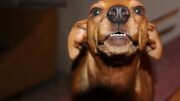The Norwegian Lundehund, also known as the Norwegian puffin dog, is an ancient indigenous dog breed. It’s treasured as a Norwegian cultural heritage.
These dogs are considered special for their unique anatomy as well as their accurate tracking and retrieving abilities.
They were once a part of people’s livelihood through hunts on seabird colonies, mainly puffins, along the coastal area of Norway.
History
According to the Kennel Clubs such as NKK, AKC, and SKK, the breed is very old. There are descriptions of the use of dogs for hunting puffins going back to more than 400 years ago.
According to the Norwegian Lundehund Club, all of the present-day Lundehunds are descendants of the dogs from the Mostad village on Værøy at the Lofoten archipelago.
The first reliable account is from 1591 when a bailiff named Erik Hansen Schønnebøl mentioned the Lundehund and puffin-hunting during his voyages to Northern Norway.
There were many other recounts of the dogs being used on the coast of Helgeland all the way to Finnmark in the 16th-17th century.
The most famous from the poem “Nordlands Trompet” by poet-priest Peter Dass.
In the 17th-18th century, their importance as working and hunting dogs was mentioned several times.
The dogs were valued for helping locals catch seabirds, which provided valuable meat and feathers.
However, around the 1850s the use of nets became popular for catching seabirds. Furthermore, as several communities along the northern part of the Norwegian coast declined, the need for Lundehunds diminished – along with their numbers.
The current Lundehunds stem from the few that survived in Røst and Værøy, and the hunting tradition was kept alive in the isolated hamlet of Mostad.
During the years between World War I and World War II, some of the dogs were sent to a breeding program at Hamar, in the southeast of Norway. At the onset of World War II, the Lundehund population amounted to about 50 dogs.
In 1943, the first wave of the canine distemper disease affected the dogs at Mostad. Thereafter, another wave of the canine distemper affected the dogs at Hamar. By the late 1950s, they were at risk of extinction.
In 1960, the breeding program was initiated again through cooperation between breeders. The Norwegian Lundehund Club was established in 1962.
Unique characteristics
The Norwegian Lundehund is a small spitz-type dog. They have supple rectangular bodies. Usually, males stand at 35 – 38 cm and weigh 7 kg, and females stand at 32 – 35 cm and weigh 6 kg.
Their double-coat has combined grey, brown, and white markings: reddish-brown to fallow colors, fur with sprinkled black tips, and darker patches. There also used to be tricolors of black and white Lundehund. Unfortunately, they no longer exist.
The morphological characteristics of these dogs vary according to males and females.
Lundehunds are noteworthy for their ability to retrieve unharmed live puffins from burrows in steep cliffs and screes.
Their extraordinary light and elastic bodies are well-suited to the crevices and tunnels when raiding nests.
Their anatomy allows them to move around rugged grounds with a good grip, and crawl into narrow passages. They have 6 fully functional toes in all legs, although some may have more toe digits.
Their ears can be retracted – that they fold and flop in a specific manner, forward and backward or upwards at a right-angle to prevent moisture and debris from coming in and to locate birds easier.
Their pliable shoulder and neck joints can also make their forelegs extend sideways at about a 90-degree angle.
The Lundehund today
These dogs are problem-solvers, lithe and lively, fitted for difficult terrains, and wet or windy weather conditions.
They make an incredible companion for long hikes. They are protective but never aggressive, and are very affectionate.
However, according to the American Kennel Club, they can be very sensitive and develop trust issues.
It is advisable to have them go through early socialization and training.
It is said that in their original environment, the dogs were not constrained as they are independent and would not go hunting without supervision.
They are still ideal for off-leash tracking, as long as it is in close proximity to their owners.
Since puffins are now a protected species, the dogs no longer perform their earlier purpose. But as their instincts and skills remain, and as huge numbers of birds present aviation concerns – particularly when it comes to collisions with aircraft – the dogs now find nests and gather eggs from seagulls at Tromsø Airport, in the northern part of Norway.
Their expected lifespan is 12-15 years. However, according to the strategy report of the Norwegian Lundehund Club, the average lifespan amounted to 9 years and 3 months in recent times.
The Lundehunds are generally healthy and low-maintenance. Although they do not have a lot of health issues, the Norwegian Lundehund Club notes that the dogs suffer from one prevalent health problem – intestinal lymphangiectasia, a type of gastrointestinal disorder.
There are also cases of patellar dislocation, cataracts, and fertility issues.
The most common causes of death are intestinal lymphangiectasia, gastrointestinal diseases, cancer, trauma, and old age.
According to the 2017 research article for Plos One Journal, the Norwegian Lundehund is a highly endangered dog breed.
Similarly, the Norwegian Lundehund Club states that these dogs are very rare and a vulnerable breed due to the insufficient number of breeders and the fact that brood females are given a year of rest after having a litter.
In addition, they have limited genetic diversity.
From the latest update in 2012, there were 582 registered Lundehund in Norway and approximately 1,400 worldwide across Europe and North America.
There is still an ongoing effort to increase the population size and expand the gene pool of the breed.
Source: Norway Today



Be the first to comment on "The Norwegian Lundehund: A part of Norway’s rich cultural heritage"